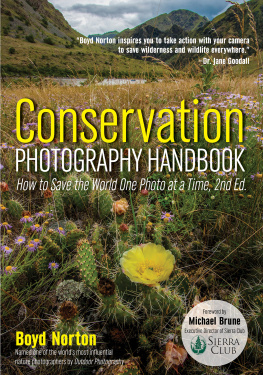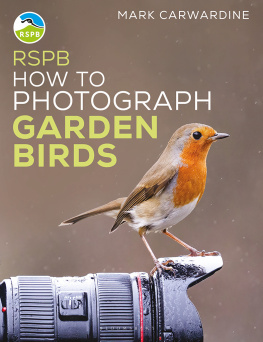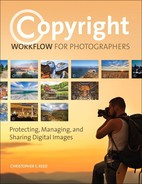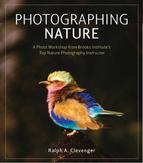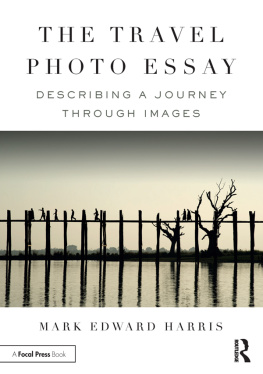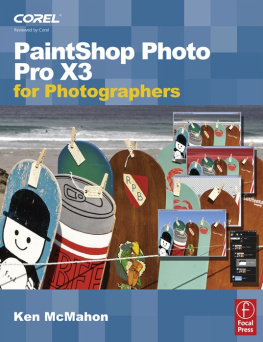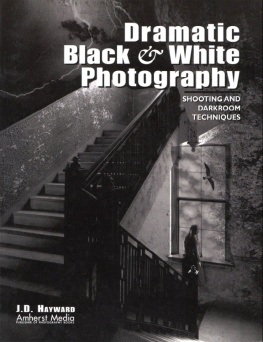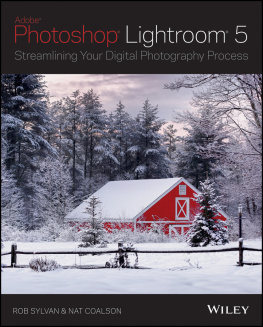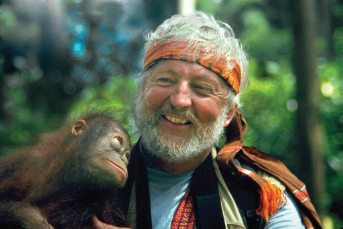
Copyright 2020 by Boyd Norton.
All rights reserved.
All photographs by the author unless otherwise noted.
Published by:
Amherst Media, Inc.
PO BOX 538
Buffalo, NY 14213
www.AmherstMedia.com
All rights reserved.
All photographs by the author unless otherwise noted.
Published by:
Amherst Media, Inc.
PO BOX 538
Buffalo, NY 14213
www.AmherstMedia.com
Publisher: Craig Alesse
Associate Publisher: Katie Kiss
Senior Editor/Production Manager: Barbara A.Lynch-Johnt
Senior Contributing Editor: Michelle Perkins
Editor: Beth Alesse
Acquisitions Editor: Harvey Goldstein
Editorial Assistance from: Carey A.Miller, Roy Bakos, Jen Sexton-Riley, Rebecca Rudell
Business Manager: Sarah Loder
Marketing Associate: Tonya Flickinger
ISBN-13: 978-1-68203-426-2
Library of Congress Control Number: 2019957390
Printed in the United States of America
10 9 8 7 6 5 4 3 2 1
No part of this publication may be reproduced, stored, or transmitted in any form or by any means, electronic, mechanical, photocopied, recorded or otherwise, without prior written consent from the publisher.
Notice of Disclaimer: The information contained in this book is based on the authors experience and opinions. The author and publisher will not be held liable for the use or misuse of the information in this book.
AUTHOR YOUR iPHONE BOOK WITH AMHERST MEDIA
Are you an accomplished iPhone photographer? Publish your print book with Amherst Media and share your images worldwide. Our experienced team makes it easy and rewarding for each book sold and at no cost to you. Email submissions: .
www.facebook.com/AmherstMediaInc
www.youtube.com/AmherstMedia
www.twitter.com/AmherstMedia
www.instagram.com/amherstmediaphotobooks
Contents
About the Author
Photo credit: Barbara Norton.
Boyd Norton describes himself as a recovering nuclear physicist. As a researcher for the Atomic Energy Commission in Idaho, he once blew up a nuclear reactor as a test. While residing in Idaho, he led several successful battles to save threatened wilderness using his photography. For the past five decades, he has been a freelance photographer and writer specializing in global environmental issues.
He is the photographer and author of 17 books, ranging in topics from African elephants to mountain gorillas, and from Siberias Lake Baikal to the Serengeti ecosystem. His past books have won numerous awards and accolades. He is at work on three more books.
In 2015, he was selected as the recipient of the Sierra Clubs prestigious Ansel Adams Award, which honors an individual who has made superlative use of still photography to further conservation causes over a lifetime.
Nortons photos and articles have appeared in most major magazines, including Time, National Geographic, Smithsonian, Natural History, Outside, The New York Times, Audubon, and many others in North America and Europe.
Throughout his 50 years of photography, writing, and environmental activism, he has played a key role in the establishment of several wilderness areas in the Rocky Mountain region, new national parks in Alaska, and in the designation of Siberias Lake Baikal as a World Heritage Site. He has testified before numerous U.S. Senate and House hearings on wilderness and national park legislation. In 1991, he met with Russias foreign minister in the Kremlin to lobby for the protection of Lake Baikal.
He is currently leading the battle to save the Serengeti ecosystem from proposed damaging developments. He has been documenting the Serengeti for over 30 years, leading photo safaris and on book and magazine assignments.
He received an award in 1980 from the Environmental Protection Agency, presented by Robert Redford, for his important, exciting environmental photography and writing.
He is a founder and Fellow of the International League of Conservation Photographers and a founder and Fellow of the International League of Conservation Writers. He has also served on the Board of Trustees of the Dian Fossey Gorilla Fund.
Boyd describes this book as a call to action, providing the tools and encouragement to become a conservation photographer and to help you save wilderness and wildlife everywhere.
Dedication
To my daughter, Jean Anne Norton, a ray of sunshine in my life and a fine photographer in her own right. She is carrying on the family conservation tradition in her adopted country, England, fighting to save Watership Down, the place in the best-selling book of the same name, and trying to stop a destructive highway through a lovely national park near her home in Arundel.
Acknowledgments
First and foremost, my thanks to my wife, Barbara, for her help and research, both of which were vital to this book. A special thanks goes to the several conservation photographers who very kindly contributed photos and words about their conservation work: Amy Gulick, Alison M.Jones, Joe Riis, Ian Michler, Katherine Feng (Wenzhen), Clay Bolt, Dave Showalter, Wendy Shattil and, sadly, to Wendys partner, the late Bob Rozinski.
A big thank you to Odalys Muoz Gonzalez for use of her award-winning polar bear photograph. Thanks to Jim and Cindy Griggs for their contribution of photos from the Maxwell Wildlife Refuge that they work so hard to protect. Another big thanks to Scott Trageser, an up-and-coming conservation photographer, for the use of his photo and words about a conservation issue that threatens many species around the world.
Id like to thank the folks at Amherst Media: Barbara Lynch-Johnt, Katie Kiss, and Craig Alesse, for their faith in the projectand their patience. Final thanks goes to my agent, Peter Beren, for his great input in the early stages of the first edition.
Foreword
When I first came to the Sierra Club, one fringe benefit I hadnt anticipated was the art. In the hallways, the offices, and the conference rooms hang spectacular photographs (and a few paintings) that not only inspire us daily but also remind us why we come to work. Many of the photographs are the work of past winners of the Ansel Adams Award for Conservation Photography, which the club has presented annually since 1971. Some of the most spectacular are by Adams himself. We dont make a big deal about them, but perhaps we should. Once, during a meeting, a volunteer leader pulled Clearing Winter Storm, Yosemite National Park off the wall so he could tape pages of brainstorming notes from an easel pad to the wall. I suspect that kind of thing doesnt happen at the Philadelphia Museum of Art.
Photography has always been important to the Sierra Club, beginning with our founder. From the beginning, John Muir understood that people would care more about protecting places they had seen. He believed that if everyone in America could experience the mountains and valleys of his beloved Sierra Nevada for themselves, then the conservation battle would be won. Clearly, though, that would be impractical. Fortunately, there was an alternative: illustrations and photographs (along with Muirs own impassioned prose) could bring the mountains to the people.
Little-known fact: Muir himself carried a camera on some of his later travels, though the results were not impressive. As a photographer, he was apparently a very good writer.
Next page
